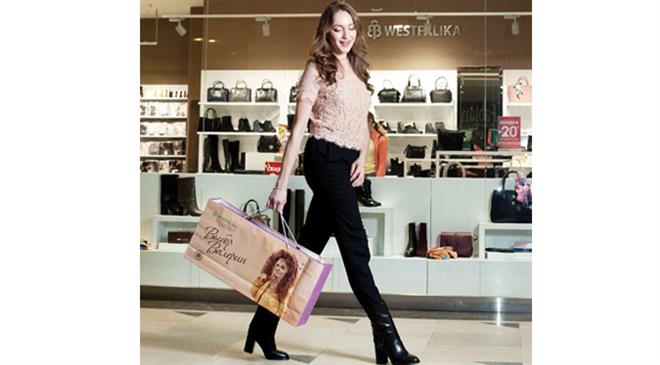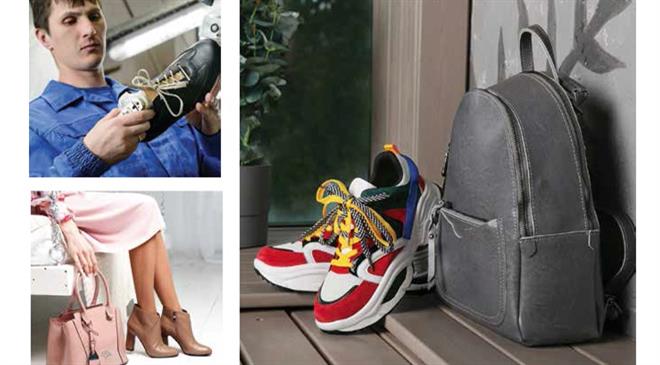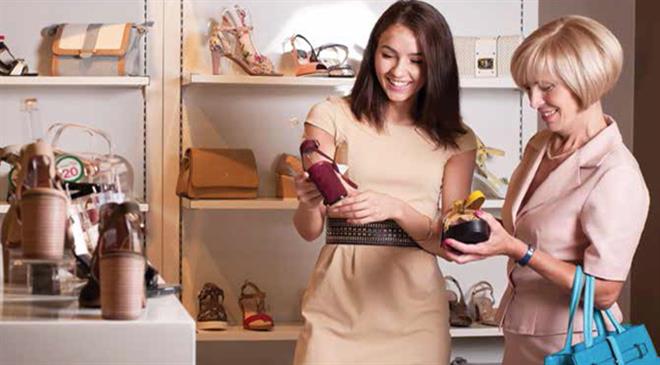Russian market offers great opportunities
Obuv Rossii is a leading Russian footwear company, the first to be publicly traded in the country's fashion retail. It manages 863 stores under the brands of Westfalika, Peshekhod, Rossita, Emilia Estra, and Lisette, in addition to the active lifestyle brands of S-TEP, All.go and Snow Guard. CEO Anton Titov discusses the highs and lows of the Russian market with Hiral Oza.
How big is the footwear market in Russia? At what rate is it growing?
The Russian footwear market is among the biggest consumer markets in the country. In 2018, it was more than 1.37 trillion RUB (or more than $21.7 billion) in value terms and more than 320 million pairs in volume terms, according to thinktank Discovery Research Group. In 2019, the market has been growing: in the first half, it increased by 10.9 per cent in value terms and by 8.7 per cent in volume terms. In the mid-run, the market will show an upward trend which will be supported by growing disposable income and consumption. As for consumption, it is still not very high in Russia-a little bit more than two pairs per capita per annum. In this respect, we lag behind European countries and the US and we have great potential for growth in the next 3-5 years. The normal level of consumption for Russia is 3-4 pairs since we have all four seasons and a rather cold winter.

What kind of footwear innovations is the R&D team at Obuv Rossii working on?
One of the flourishing areas are polymer materials, for example, EVA. We experiment with such materials since they enable us to improve consumer properties such as lightness, durability, frost-proof, etc. We also cooperate with Novosibirsk Technological Institute-it is one of the leading industrial research and educational institutions in Russia. We test new materials, develop new technologies like anti-slipping soles and record patents.
We also develop a lot of new models for special purposes and industrial footwear which endure extreme loads and can be exploited in special conditions. This year we issued a new model for the food and pharmaceutical industries. This group's own development fully complies with requirements of special purpose shoes. We developed this new model together with one of the biggest food holdings in Russia which enabled the group to carry out field tests for the new type of shoes in real production conditions and improve the model considering all the recommendations. Usually, we use modern materials for the sole and upper part; different construction peculiarities allow us to introduce innovative products which have no counterparts in our market.
You are among the first in the Russian retail to introduce blockchain in your business. How has it helped you?
Due to blockchain, we tackle the task of personal data protection which is very important for our company as we offer our clients a range of financial services like instalments payments, cash loans, etc. The base of clients using these services has been increasing and now makes up more than 1.3 million people. Meanwhile, our retail chain is growing too, and we need to provide data protection and its integrity as employees in our stores in regions all over Russia are involved in the process of providing services and constituting agreements with our clients.
Thanks to blockchain, we guarantee that the information about all the transactions is unchangeable. We exclude a possibility of any unauthorised changes which may be a result of both external and internal interferences. The task to organise control at the local level has also become simpler. The company uses a two-level encryption system and stores data on transactions in a distributed manner in three data processing centres-in Novosibirsk (Siberia), Khabarovsk (Far East) and Moscow (Central Russia). One more result is worth mentioning: we have tested new technology and now we consider replicating it in other business processes such as loyalty programme and accounting.

You were the first company to be listed in the Russian shoe and fashion market in 2017. How has the growth been?
When we held an IPO on the Moscow Exchange in October 2017 we announced our investment programme for three years. An important element of this is the growth of our retail chain. Our aim was to double our retail network and to increase it up to 1,000 stores in three years. Since 2017, we have been implementing this strategy. Last year, we launched 192 new stores and entered 80 new cities. In the first half of this year, we rolled out 110 stores and enhanced our footprint by 92 new cities and towns. As of August 31, our retail chain comprised 884 stores in 353 cities and towns all over Russia.
Another important element of our strategy is LFL sales increase due to improved technologies, stock diversification and development of additional services. In the first half of 2019, total like-for-like revenue of the Obuv Rossii Group rose by 7.7 per cent. Now, we sell not only footwear but also a wide range of related products, apparel and accessories. In 2018, the share of related products in retail proceeds reached 35 per cent.
We focus on improving our customer experience through the development of omni-channel sales, introduction of new services and the development of innovative loyalty programmes. We operate five online stores, constantly modernise business processes and improve online orders processing and terms of delivery; we also cooperate with marketplaces. In 2018, our online sales grew by 10.3 per cent, and the share in retail revenue reached 13 per cent.
One more strategic goal is to improve our value chain due to development of unique product lines, supplier chain and introduction of new IT solutions. We have our own R&D centre which deals with new materials and tests new technologies. We embed them into our in-house footwear production as well as in outsourcing. We pay much attention to our IT infrastructure, invest in new IT solutions, introduce new ones which have no counterparts in the market. We consider IT to be one of the important competitive advantages of modern retail since stores of the future are not just shelves for goods but multifunctional service points which offer a wide range of high-technological services to their customers. That is why we launch new services for customers, scale up omni-channel sales and introduce an innovative loyalty programme which is not confined to bonuses and discounts.
What are the latest footwear market trends in Russia?
Many trends like materials, styles, etc, come from sports footwear to everyday shoes. One of the main trends is the increasing popularity of casual style footwear like sneakers, slip-ons, canvas shoes, etc. For the last several seasons, the share of high heels in women's collection has been declining, and at the same time the share of casual style, comfort flat shoes has been growing. It characterises not only spring-summer collections but also autumn-winter ones. Now it is widespread practice to combine classical suits and elegant dresses with sneakers. In mainland Europe, footwear made of synthetic leather and other materials is in high demand. We do not have the same trend in Russia since there is a rather cold winter and people still prefer footwear manufactured of natural leather and fur.
Regarding women's shoes, boots with thick, massive wedges are among the hottest trends. Heels are still popular, but they should be comfortable and attractive. So, different forms of heels are fashionable, for example, wedge heels, V-shaped, four-square, globeshaped. Ugg boots of bright colours with fur and other décor are still appealing. Animalistic and reptilian prints are among must-haves of each collection.
As for men's collections, sneakers are very popular, not only for summer but also winter. Cold-proof sneakers with natural and synthetic fur are included into the range of goods of Russian footwear stores. Men have started paying more attention to fashion trends. So, their footwear is not so conservative and dull as it was 10 or 15 years ago. In addition to classic black and brown colours, blue and mustard ones attract attention of male consumers. Accessories such as buckles, bright lace or straps is a common element of various men's shoe models.

What is your production capacity?
The annual footwear production capacity of our units is 500,000 pairs. We mostly manufacture footwear of casual style for all seasons, special purpose and industrial footwear, and niche footwear for hunters and fishermen. We produce footwear with any type of sole attachment-cement, injection moulded and combined construction methods. We manufacture footwear made of natural leather, textile and polymer materials like EVA.
Where do you source raw materials and parts for footwear?
We cooperate with Russian manufacturers of leather, compounds and other materials as well as with foreign suppliers (from China, Italy and other countries).
Which price points are the most preferred by Russian consumers?
The biggest market share belongs to the low-price segment with prices up to 3500 RUB ($45-50). In 2018, it amounted to 851 billion RUB ($13.5 billion, 62 per cent of the market in value terms). The second biggest price segment is mid-price which we focus on. It accounted for 29 per cent of the market in value terms in 2018. We consider it attractive since thanks to growing disposable incomes and a change in consumer behaviour, people prefer high-quality shoes of well-known brands for affordable price more and more. Many consumers who get used to buying high-quality shoes stick to their favourite brands even during the periods of downturn.
What kind of challenges threaten the growth of the Russian footwear industry?
One of the main challenges is not very high purchasing power of potential customers. The fact is that in Russia real disposable incomes have been declining for five years in a row. This year it is expected to tick up, in the next 3-5 years the pace of growth is likely to speed up. To cope with the situation our company is diversifying its assortment, and developing new lines like apparel. Due to these measures, we have managed not only to maintain but also to increase our like-for-like sales. One more instrument is the development of financial services like instalment payments which enhance the purchasing opportunities of our clients and enable them to buy more. So, for retailers to succeed in the situation of sluggish consumer spending, it is necessary to be rather creative, introduce new approaches, develop new retail formats and invent new services, which result in a loyal customer base growth.
Another challenge is a big shift in the market when the share of online sales is growing pretty fast. The main obstacle for development of online sales in Russia is logistics because it is a big country. There are a lot of remote areas which do not have good access to transportation. However, big players in the e-commerce market and logistic operators have done a lot to overcome these hurdles and have been building a network of pick-up points all over Russia cooperating with traditional retailers as well. For example, as I mentioned, we have been expanding the project of pick-up points for third party online stores since October 2018.
To adapt to new conditions, footwear retailers and manufacturers are launching their own online stores as well as cooperating with marketplaces. To be successful, it is necessary to develop different sales channels for synergy. As we see, many people demonstrate ROPO behaviour (research online purchase offline), especially in the footwear sector where a consumer first tries on and then buys. For example, more than 90 per cent of our online store clients prefer to pick up their orders in our brick-and-mortar stores so that they can try on and, if a pair does not fit, choose another one. Therefore, for any brand it is vital to be present both online and offline.
If we talk about footwear production, there are two challenges. The first is lack of domestic materials and footwear components, most of which domestic manufacturers must import, and which in turn leads to an increase in the cost of production. It is necessary to develop our in-home supply chains of raw materials and build an infrastructure for the footwear industry. For this, we need time, investments and government programmes for industrial development. The second challenge is the limited access for small and mid-size companies to source finance. To start a manufacturing project, you need longterm investments, but it is not so easy in Russia to get those from banks unless you are big enough. (HO)






